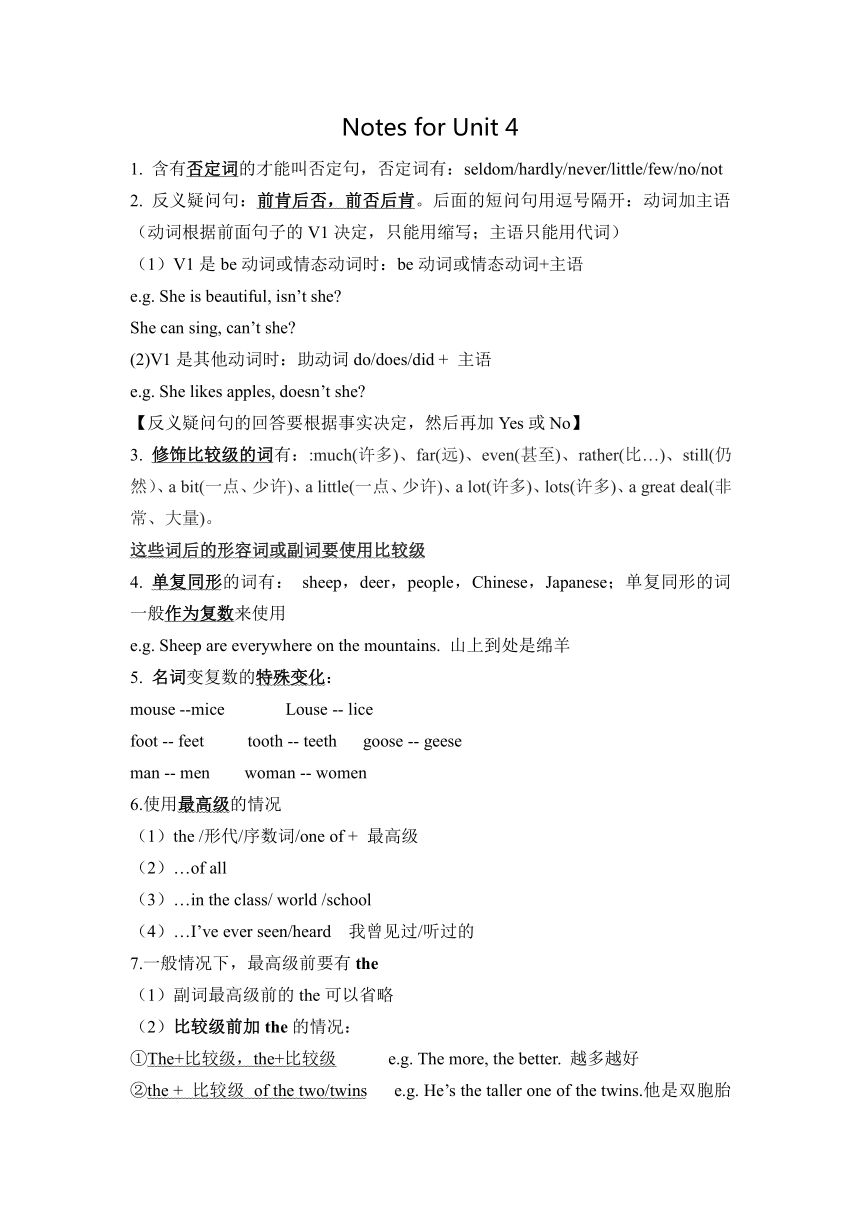
Notes for Unit 4 含有否定词的才能叫否定句,否定词有:seldom/hardly/never/little/few/no/not 反义疑问句:前肯后否,前否后肯。后面的短问句用逗号隔开:动词加主语(动词根据前面句子的V1决定,只能用缩写;主语只能用代词) (1)V1是be动词或情态动词时:be动词或情态动词+主语 e.g. She is beautiful, isn’t she She can sing, can’t she (2)V1是其他动词时:助动词do/does/did + 主语 e.g. She likes apples, doesn’t she 【反义疑问句的回答要根据事实决定,然后再加Yes或No】 修饰比较级的词有::much(许多)、far(远)、even(甚至)、rather(比…)、still(仍然)、a bit(一点、少许)、a little(一点、少许)、a lot(许多)、lots(许多)、a great deal(非常、大量)。 这些词后的形容词或副词要使用比较级 单复同形的词有: sheep,deer,people,Chinese,Japanese;单复同形的词一般作为复数来使用 e.g. Sheep are everywhere on the mountains. 山上到处是绵羊 5. 名词变复数的特殊变化: mouse --mice Louse -- lice foot -- feet tooth -- teeth goose -- geese man -- men woman -- women 6.使用最高级的情况 (1)the /形代/序数词/one of + 最高级 (2)…of all (3)…in the class/ world /school (4)…I’ve ever seen/heard 我曾见过/听过的 7.一般情况下,最高级前要有the (1)副词最高级前的the可以省略 (2)比较级前加the的情况: ①The+比较级,the+比较级 e.g. The more, the better. 越多越好 ②the + 比较级 of the two/twins e.g. He’s the taller one of the twins.他是双胞胎中比较高的那一个 “越来越……” 加er构成比较级的词: 比较级 and 比较级 e.g. more and more taller and taller (2)加more或less构成比较级的词:e.g. more and more + adj./adv. e.g. less and less +adj./adv. e.g. more and more serious /less and less serious 9. stop后可以加to do,表示后面的一件事情没有做 也可以加doing,表示停下后面那件正在做的事情 e.g. ① You are so tired. Please stop to have a rest.你太累了,停下休息一下吧 ②When the baby saw his mom, he stopped crying.当婴儿看见母亲时,它停下哭泣 10.can’t stop doing...情不自禁做某事 e.g. After watching this video, we can’t stop laughing. 看完这个录影,我们情不自禁大笑起来 Sit 动词,“坐下” e.g. sit down 坐下 Seat 名词,“座位” e.g. book a seat 预定座位 12.百分数修饰的名词才是主语 如:80 percent of students like phone games. 【students是主语】 13.后面加动词原形的词:情态动词(can/could/may/might/should/must),let,please,be going to,have to,help,be able to 14.后面加ing的词:like, love,hate,keep,enjoy, start , finish, mind, practice ,spend (in) doing, be busy doing, have a good time doing, have fun doing, 15.It’s adj. for sb. to do... 对于某人来说做某事是…… 当adj.是表示人的品质的词时,for要改成of 表示人的品质的形容词有:nice (性格好的)/kind(善良的)/mean(刻薄的,吝啬的)/polite(礼貌的)/honest(诚实的) 等 more/less不能与-er一起出现 Most/least不能与-est一起出现 “的”字的表达 ’s 表示有生命物体的“的” e.g. Lily’s book 莉莉的书(莉莉有生命) Of表示无生命的“的” e.g. the window of the room 房间的窗户(房间无生命) 部分名词后只能用to表示“的”:key/ answer / door / bridge/way to …的钥匙/答案/门/桥/方式 某人“有”某物,have表示有 [这里的“人”指有生命的物体] 某地“有”某物,there be表示有 e.g. ① ... ...
~~ 您好,已阅读到文档的结尾了 ~~